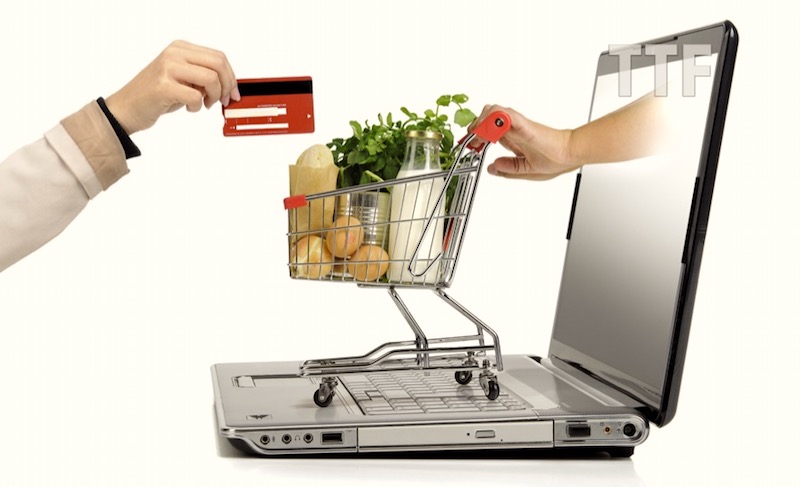
Zara Stone
In New York, Amanda Wood has been waiting more than two weeks for an Amazon Fresh delivery slot. Her order includes bread, eggs, toilet rolls, and diapers. “Diapers are the priority,” says Wood, who has an eight-month-old son. Wood’s a first-time online grocery shopper, and so far, she’s unimpressed with the process. She spent over an hour loading up her online cart, only to find numerous items suddenly “out of stock” at checkout, and no free delivery slots available. “Why did they let me think I could order it if they didn’t have it?” she says. “If I wasn’t in lockdown, I would never shop like this again.”

Wood’s pain points echo that of millions of Americans, whose attempts at online grocery shopping have been a source of frustration — so much so, that some enterprising people resorted to bots to snatch up delivery slots. But with supermarket foot traffic down, why is it so hard to order groceries to our homes? The answer: a complex snarl of bureaucracy, lack of investment, outdated systems, and antiquated store designs.
For starters, online grocers just weren’t ready for this. “This level of online shopping was, at best, forecast to occur five years from now,” says David Bishop, a partner at grocery research consultancy Brick Meets Click. “The demand has overwhelmed the capacity of the retailers.” In 2019, Bishop reports that 6.3% of grocery-related spending was through online orders, bringing in around $29 billion in U.S. orders alone. That’s a lot of green, but it’s a fraction of the $650 billion industry. “Shopping online costs more for the retailer, and was a low priority for grocery stores,” Bishop says. “They offered it as an add-on, not a core part of their business.”
Everything flipped this March. With shelter-in-place orders across the country, online groceries are now a hot commodity. About 40% of orders come from first-time shoppers, according to Gordon Hasket Research. But the expectation of fresh food, straight to your door, a la Amazon packages, is failing across the board, as Whole Foods, Safeway, Peapod, Kroger, Target, Shipt, Instacart, and others lack the manpower, inventory, and infrastructure to cope.
Why grocery delivery takes so long
The delivery issues start at the supermarkets themselves, says Pradeep Elankumaran, the CEO of grocery delivery startup Farmstead, whose San Francisco delivery-only micro hub competes with online grocers (they were poised to expand to the Carolinas pre-pandemic). His vision is small, centralized stores, staffed by a lean team, serving fresh produce to the community. “The current model is incredibly inefficient — you have bigger warehouses, further away, with very inflexible shopping schedules,” he says. “Each grocery store can only do about 150–200 orders, max, per day. If you do the math, it’s about 7.5 million orders per day, for 128 million U.S. households.” Stores run deliveries from a retail mindset, not an e-commerce one.
Most grocery stores were not designed for quick in-and-outs. Their layouts have had an Ikea-like quality, designed to maximize shopper spending.
Prior to Covid-19, many deliveries were boxed by regular grocery staff, with no special delivery training, says Benjamin Lorr, author of The Secret Life Of Groceries. “Stores cared about the customer experience and deliveries were less important,” he says.
And most grocery stores were not designed for quick in-and-outs. Their layouts have had an Ikea-like quality, designed to maximize shopper spending. Meaning that, for many online orders, a worker must physically trek through a grocery store designed to slow them down. “Their layouts are not conducive to e-commerce,” says Elankumaran. For instance, Farmstead’s San Francisco hub has less shelf space than a traditional store, meaning a smaller “but curated” selection of groceries; a thousand or so items, instead of the 45,000 found at major chains. Inside, items are sorted by popularity, not mandated sections; the goal is quick fulfillment, not browsing. “We’ve noticed that people are buying more meat, and a lot, lot, more mac and cheese,” he says.
Because Elankumaran built his company for e-commerce, Farmstead is able to ship more orders with a small team. Since lockdown, Farmstead’s orders have skyrocketed, with an estimated 30–100% growth week-over-week, he says. Ten to 12 social-distancing employees work the floor of Farmstead’s hub, bagging orders and ice packs into tote bags, working on multiple orders simultaneously for hundreds of customers a day. A model he says is more efficient than, say, Instacart shoppers at Trader Joe’s. “What you have is essentially a proxy shopper — that’s a one-to-one mapping, which is really inefficient in an e-commerce setting.” It works okay with a few orders, but is — as we’ve seen — easily overwhelmed.
Farmstead, Amazon Fresh, Whole Foods, and more have enacted waitlists for new customers, to mitigate expectations. Others, including Amazon and Kroger, are piloting to Farmstead’s “dark store” model — turning their base grocery stores into warehouses, closing their doors to consumers, and operating on a delivery or pickup-only model.
Trouble in the supply chain
Adding to this problem are the supply chain issues, which have led to stock shortages of things like toilet paper and meat. Supply chain is an umbrella for multiple moving parts, including planning, sourcing, manufacturing, warehousing, transportation, and support. “Think of it as an orchestra,” says Abe Eshkenazi, the CEO for the Association for Supply Chain Management. “Each part has a specific activity. When you change the output — such as more cold storage, or trucks—it needs to be sequenced, and this takes time.” There’s also the monetary cost of scaling up—“often millions of dollars to change packing and reroute trucks, and so on,” he says. “I can’t say, if you just fix X then it works — it’s not just one thing.”
That’s where the stories about dairy farmers dumping milk, and $5 billion of fresh fruits and vegetables gone to rot come from. “They’re in a position where they either can’t maintain the freshness or there’s no way to get it to market,” he says. “The majority of the products that are available today were planned six to eight months ago.” Shifting from a restaurant and retail supply chain to a home-based one is another holdup; items need to be repackaged from bulk to individual servings, “for a customer who has different expectations in terms of variety, quantity, and frequency of their orders.”
The big question
There’s still the question of long-term adoption — will people still shop like this when the crisis abates? And that question is holding businesses back from making big changes to the supply chain in order to fix some of these issues.
For his part, Elankumaran thinks customers will continue to shop for groceries online. He’s hoping to retain customers by focusing on price points. “People want to pay the same price as they’re already paying for the same amount of food,” he says. “But that’s never been fulfilled for online groceries.” At Farmstead, he makes a point that what people pay is the same they would in stores. “Customers come back [if you] give them the right prices,” he says — that’s important when you factor in that only 43% of new online grocery shoppers say they’d use their provider again, according to Brick Meets Click.
Price has always been an issue with online orders. “You can easily pay 10% more for shopping online,” says Bishop. “There is a value for that if you’re a young parent, but for many, as concerned as they are about the crisis, they can’t justify shopping online.” Most online grocers don’t accept SNAP either, though Walmart and others have pilot programs underway.
To scale online groceries, there needs to be some serious investment, in infrastructure, and in technology, says Bishop. For example, inventory management: What shows as available online needs to follow through to your cart. Walmart and Target do a great job of letting customers toggle what’s out of stock, he says, but they’re not the norm.
Food growers and other parts of the supply chain have been slow to respond, stymied by the lack of long-term data, says Eshkenazi. “They don’t want to carry excess inventory of perishable foods to meet a short-term need. The challenge is we don’t know the duration of the disruption, so they can’t forecast when to move out of a short-term fix and into a long-term one,” he says. “They’re concerned if they’re able to recoup [investments] over the long term.”
There’s a basis for that — companies that ramped up their mask-making in the SARS crisis were forced to lay off staff when demand dipped, so it’s understandable that businesses are wary.
But as much as Eshkenazi would like this solved, yesterday, he commends them for taking time to think about it. “It’s too easy to make very short-term decisions that would have a more long-term impact on a sustainable supply chain.” Which makes sense, but probably won’t get you your TP and milk any quicker.
Source:



